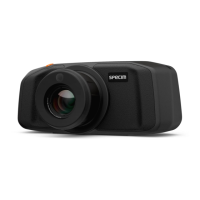| Introducing the Specim IQ Imaging System | 7
Data Cube
In short, a data cube is a three-dimensional array of values.
In Spectral Imaging on page 5, we discussed about the model. If we look at the data cube of a conventional
photograph, it can be seen as a book that has three translucent pages:
1.
The first page contains the red wavelengths. The wavelength range of the page is approximately 75 nm.
2.
The second page contains the green wavelengths. The wavelength range of the page is approximately 100 nm.
3.
The third page contains the blue wavelengths. The wavelength range of the page is approximately 150 nm.
When we look through the pages of the book, we see the picture in full colour as depicted on the cover of the book in
the figure below.
In IQ, the book consists of up to 220 pages. The wavelength range of each page is approximately 2.7 nm.
Dark Frame
Like any camera, the Specim IQ sensor produces some dark current, which accumulates in the pixels during an
exposure. This generates noise, which affects the resulting image. Dark current is caused by heat and it accumulates
at a different rate in every pixel. If the dark current accumulates fast in a pixel, the pixel is called a hot pixel.
Fortunately, each pixel is consistent in its dark current at any one temperature.
The effect of dark current can be decreased by capturing a dark frame, which consists of nothing but the dark current
pattern, and subtracting that frame from the light frame. This procedure removes the fixed dark current pattern from
the image.
As said, the rate of dark current is constant, but the actual accumulation of dark current is random. In other words, the
dark frame is not enough, if we want to produce as noiseless images as possible. To improve the image, the system is
able to detect the especially hot pixels and replace them with the average of the surrounding pixels. This procedure is
called bad pixel replacement.
White Balance
Each light source has its own color temperature, mesaured in Kelvins and seen as the relative warmth or coolness of
white light. The human eye has no difficulty in detecting really white areas in any light, but digital cameras do. This
inability leads to pictures tinted to, for example, blue or orange.
As digital cameras have difficulties in detecting really white areas, we must indicate a neutral reference to the camera.
In other words, we show to the camera an area that is really white. Occasionally, you can find a neutral reference on
your scene, but usually you carry a pre-made neutral reference with you.
Illumination
In spectral imaging, good illumination playes a bigger role than in conventional digital imaging. More captured
wavelengths require more light. Referring back to our book example, the light can be seen as ink on paper. In the red,
green and blue model, we only need light for three pages, whereas in spectral imaging, we need light for up to 220
pages.
To obtain good illumination, illuminate the whole object as evenly as possible within the entire spectral camera view.
Make sure there are no shadows or specular reflections.
Data set
A dataset refers to a single measurement made with the Specim IQ. A dataset is structured as follows:
• At dataset root:
• The manifest.xml file. This file lists the files in the dataset.
• An image from the viewfinder camera.
• An image from the spectral camera.
• Folders:

